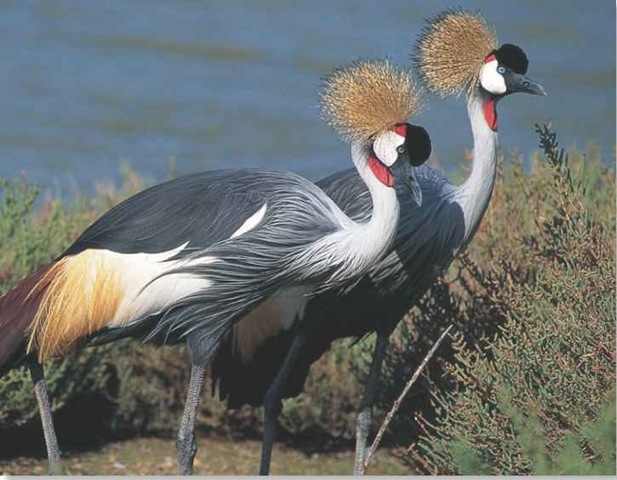ORDER
Gruiformes
FAMILY
Gruidae
GENUS & SPECIES
KEY FEATURES
• Leaps up to 7′ in the air in elegant ritual dances that are performed by excited groups all year
• Most brilliantly colored and ornately plumaged of all the world’s 15 species of crane
• Stamps on the ground to disturb invertebrate prey that it snaps up with its thick bill

WHERE IN THE WORLD?
Found from Kenya and Uganda south to South Africa with a band extending westward to northern Nambia and Botswana
Lifecycle
As if performing to a well-known piece of music, groups of gray-crowned cranes display their regal crests and plumage to dramatic effect in their balletic ritual dances.
Habitat

A Plain sailing Long legs let this crane wade through “seas” of grass.
The gray-crowned crane lives in dry and wet lowland areas, including savannah grasslands, marshes, damp fields and the exposed shores of lakes and rivers. But unlike most other species of crane, it needs woodland to provide shade during the day as well as roost sites at night. Due to its size, it prefers open-canopied trees that afford excellent views from their high, bare branches.
Roost sites are rarely far from the best feeding areas; the crane usually makes its twice-daily journeys on foot. Although not migratory, it will fly off in search of food or water farther afield if local conditions deteriorate, such as during long periods of drought.
Conservation
Extensive wetland drainage and tree loss have reduced the gray-crowned crane’s habitat, but it’s not yet under threat and is common in some areas. But eggs and young are taken for zoos and parks as its colorful plumage is much admired.
Food & feeding
The crane feeds mainly on the seeds of wild grasses and sedges, plucking them deftly with its stubby bill. But when it has the chance, it also takes advantage of cultivated crops, including millet, corn and rice.
Invertebrates, chiefly flies and grasshoppers, also form a significant part of the bird’s diet. The crane either flushes these itself, by stamping on the ground, or wanders among cattle as they feed, waiting for them to disturb something edible. The crane also recognizes the potential of recently plowed land and searches and digs in the furrows for invertebrates brought to the surface. This powerful bird also captures and eats fish, amphibians and lizards.
# The long, hollow bones of the gray-crowned crane are made into flutes by local tribespeople.
# When unable to find shade from the sun, the gray-crowned crane cools itself by panting.
The gray-crowned crane only utters its far-carrying, trumpeting calls when in flight: even its dramatic display dances are performed in total silence.
Behavior
During and outside the breeding season, the crane performs dancing displays. These dances usually involve pairs, but other birds often join in to form dancing “troupes.” Like ballet dancers, they move in choreographed precision. Prancing and leaping on slender legs, they crane their necks and flap their wings with fervor as the display progresses.
The crane is a social bird that forms large flocks in autumn and winter At these times, the crane may be attracted to ripening agricultural crops. This can bring it into conflict with farmers, since a large flock can cause a significant amount of damage, as crops are eaten and trampled underfoot.
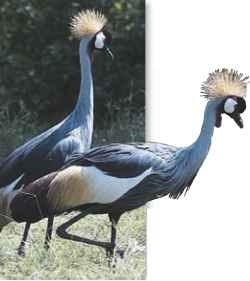
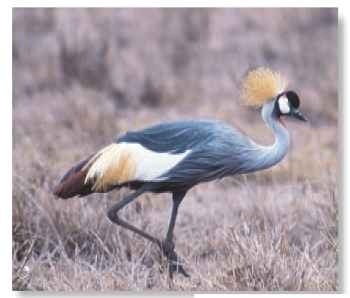
Picking its way
The crane plucks seeds and insects from the ground as it walks.
natural performers
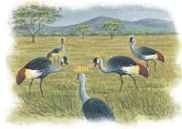
Opening moves…
A pair of cranes starts to display, bobbing up and down in unison, encouraging others to join in.
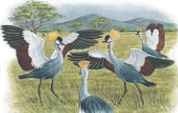
All in a flap…
Spreading their wings, the cranes hop and prance, moving away from each other, then regrouping.
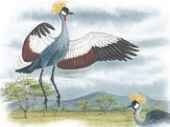
Dancing on air…
At the height of the display, a crane leaps vertically up into the air, jumping twice its own height.
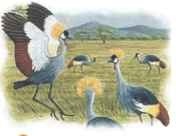
Back to earth
When the crane descends, it dangles its legs to slow its fall and cushion the impact.

A Side by side Parents guard their offspring very closely.
During the breeding season, paired cranes are inseparable, rarely moving more than 10′ away from each other When performing their mating dance, both birds bob up and down and leap toward each other with wings flapping. They circle and leap away until they’re 100′ apart, then turn and leap toward each other again.
After mating, both adults throw grasses, sedges and rushes in a heap, then trample them into a nest. A clutch of two or three eggs is incubated by both birds for four weeks. One bird is always at the nest while the other roosts in a tree or feeds 3-7′ from the nest. Chicks hatch within a day of each other and leave the nest with the parents in two days.Young stay close to their parents in the four months it takes to fledge.
Biding its time A juvenile doesn’t attain its adult plumage for four years.
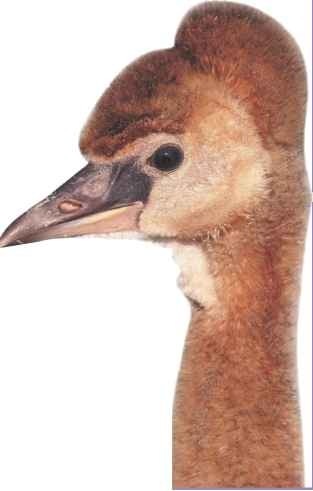
PROFILE
Gray-crowned Crane
The striking gray-crowned crane is adapted to feeding in open country, wading through open grasslands on its long, strong legs to find food.
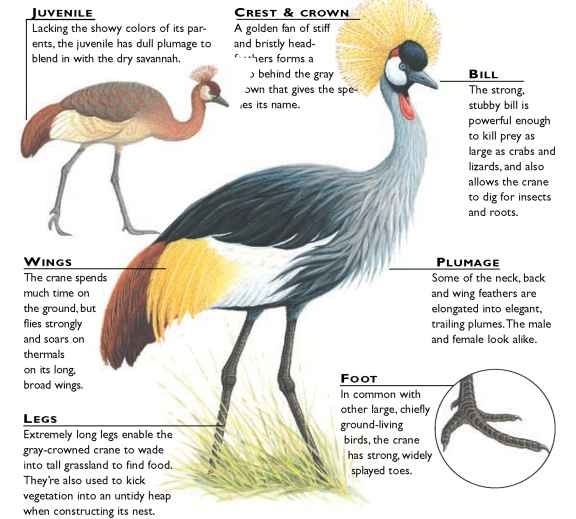
Creature comparisons
A little shorter than the gray-crowned crane, the demoiselle crane (Anthropoides virgo) appears to be much smaller because it lacks a crest and is paler in color It’s mainly gray, with black feathers on its face and neck that form a drooping “beard.’The demoiselle has white “ear-tufts,” which lie along the back of its neck
Both have the long legs and neck typical of all cranes, but the demoiselle’s neck is shorter in relation to its body. Its red eyes are very conspicuous, unlike the dark eyes of the gray-crowned crane. The demoiselle inhabits the dry grasslands of Eurasia, wintering in the Indian subcontinent, Sudan and Ethiopia.
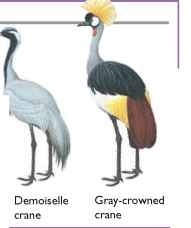
| VITAL | |
| STATISTICS Weight 8 lbs. |
|
| Length Wingspan | 3′ 6-6.5′ 4 years |
| Sexual Maturity | |
| Breeding Season | July-January |
| Number of Eggs | 2 or 3 |
| Incubation 1 Period | 28-31 days |
| Fledging Period | 16 weeks |
| Breeding Interval | 11 year |
| Typical Diet | Seeds, roots; insects, other invertebrates; crabs, lizards, fish and amphibians |
| Lifespan | Up to 20 years |
RELATED SPECIES
• Once, the gray-crowned -crane and black-crowned crane, Balearica pavonina, were thought to be two subspecies of crowned crane. Now, they’re recognized as two of the 15 crane species I in the family Gruidae, including the common, whooping, sandhill, sarus; black-necked, hooded, wattled, Manchurian; Japanese, Siberian white; demoiselle and Stanley’s cranes, and the brolga.
